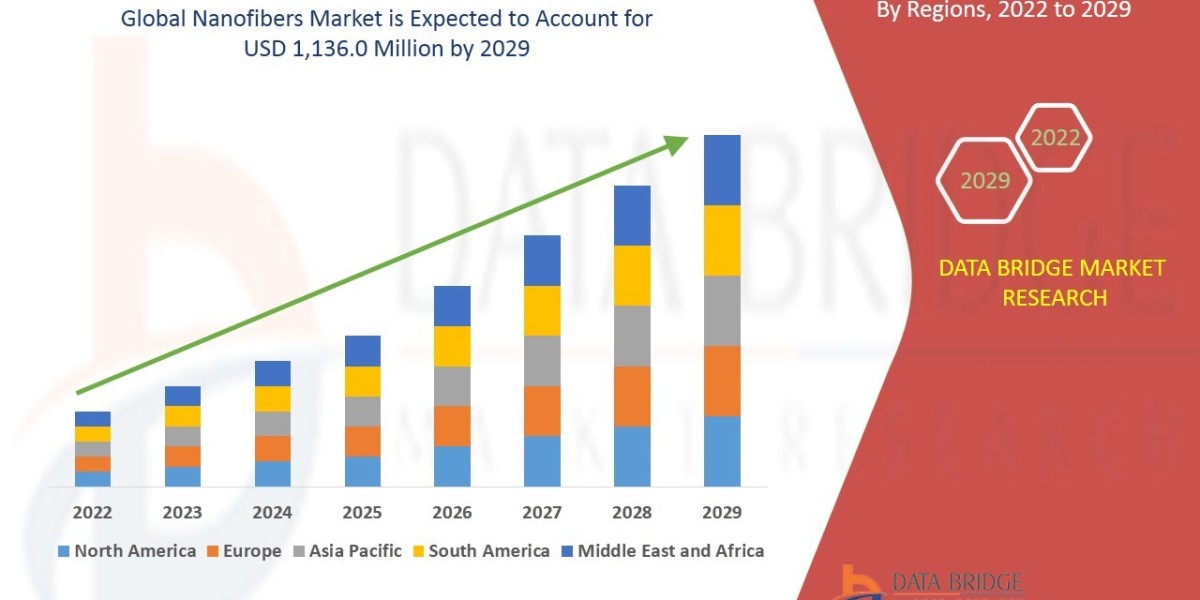"Nanofibers Market Size, Share, and Trends Analysis Report—Industry Overview and Forecast to 2029
According to Data Bridge Market Research firms, the Nano Textile Market is set to achieve robust growth, supported by emerging economies and digital transformation. Companies operating in the Advanced Fiber Technology Market are leveraging advanced technologies to enhance productivity and meet consumer expectations. The demand for customized solutions is rising, further driving expansion in the Electrospun Fibers Market. Leading industry players are focusing on research-backed strategies to strengthen their market position. As competition intensifies, businesses in the High-Performance Fibers Market are utilizing detailed market research reports to understand shifting trends, consumer behavior, and future opportunities in the Smart Fibers Market.
The Nanofibers Market is poised for significant growth, with a market outlook highlighting substantial growth potential driven by emerging opportunities in key sectors. This report provides strategic insights, demand dynamics, and revenue projections, offering a comprehensive view of the future landscape, technology disruptions, and adoption trends shaping the industry’s ecosystem evaluation. According to Data Bridge Market Research The nanofibers market is expected to gain market growth in the forecast period of 2022 to 2029. Data Bridge Market Research analyses the market will stand tall by USD 1,136.0 million by 2029 to grow at a CAGR of 17.5% in the above-mentioned forecast period.
Leading market research reports highlight the growing use of advanced solutions in the Ultrafine Fibers Market to improve efficiency and sustainability. Businesses are adapting to regulations, integrating technology, and refining their strategies to stay competitive in the Nanostructured Materials Market. The rise of digital transformation has reshaped the Functional Fibers Market, pushing companies to invest in automation and smarter business models. With demand rising, companies in the Microfiber Market are focusing on innovation and customer engagement to stand out. As the industry expands, the Sustainable Nanofibers Market presents endless possibilities for businesses ready to embrace change.
Our comprehensive Nanofibers Market report is ready with the latest trends, growth opportunities, and strategic analysis. https://www.databridgemarketresearch.com/reports/global-nanofibers-market
**Segments**
- **Type**: Nanofibers market can be segmented based on the type such as carbon nanofibers, composite nanofibers, metallic nanofibers, ceramic nanofibers, and polymer nanofibers. Each type has unique properties and applications, catering to diverse industry needs.
- **Application**: In terms of application, the market can be segmented into healthcare, electronics, energy, aerospace, automotive, and others. Nanofibers find extensive applications across various industries due to their exceptional properties such as high strength, flexibility, and conductivity.
- **Production Method**: Nanofibers can also be segmented based on their production methods including electrospinning, template synthesis, self-assembly, and others. The production method significantly impacts the characteristics of nanofibers, influencing their suitability for different applications.
**Market Players**
- **Ahlstrom-Munksjö**
- **Asahi Kasei Corporation**
- **Donaldson Company, Inc.**
- **eSpin Technologies, Inc.**
- **Finetex EnE, Inc.**
- **Nanoval GmbH & Co. KG**
- **Toray Industries, Inc.**
- **Asahi Kasei Corporation**
- **DuPont**
The global nanofibers market is witnessing significant growth owing to the increasing demand for advanced materials across industries. The segmentation of the market based on type, application, and production method provides a comprehensive understanding of the market dynamics. Carbon nanofibers, composite nanofibers, metallic nanofibers, ceramic nanofibers, and polymer nanofibers are the key types dominating the market, each offering unique advantages for various applications. In terms of applications, nanofibers are widely used in healthcare, electronics, energy, aerospace, automotive, and other industries due to their exceptional properties. The production methods such as electrospinning, template synthesis, and self-assembly playThe global nanofibers market is experiencing robust growth driven by the increasing demand for advanced materials in a wide range of industries. The segmentation of the market based on type, application, and production method offers valuable insights into the dynamics of this market. Carbon nanofibers are one of the key segments within this market, known for their high strength and conductivity, making them ideal for applications in aerospace, automotive, and electronics industries. Composite nanofibers, on the other hand, offer a combination of properties from different materials, making them versatile for use in various applications across industries. Metallic nanofibers are valued for their durability and resistance to corrosion, making them suitable for applications in healthcare, energy, and automotive sectors. Ceramic nanofibers are known for their thermal insulation properties, finding applications in the aerospace and electronics industries. Polymer nanofibers are widely used for their flexibility and biocompatibility in healthcare and other sectors.
Regarding applications, nanofibers play a crucial role in the healthcare industry, where they are used in tissue engineering, drug delivery systems, wound dressing, and surgical implants due to their biocompatibility and unique properties. In the electronics sector, nanofibers are utilized for their high conductivity and lightweight properties in applications such as sensors, batteries, and electronic components. The energy industry benefits from nanofibers for improving the efficiency of fuel cells, solar cells, and energy storage devices. Aerospace and automotive industries use nanofibers for their lightweight, high strength, and thermal resistance properties in components such as composite materials, coatings, and structural parts. Other industries also leverage nanofibers for a wide range of applications, reflecting the versatility and potential of these advanced materials.
The production method of nanofibers is a critical factor influencing their properties and suitability for different applications. Electrospinning is a commonly used method that involves creating nanofibers through the application of an electric field to a polymer solution or melt. Template synthesis utilizesThe global nanofibers market is witnessing significant growth driven by the rising demand for advanced materials across various industries. The segmentation of the market based on type, application, and production method provides a comprehensive insight into the market landscape. Carbon nanofibers, composite nanofibers, metallic nanofibers, ceramic nanofibers, and polymer nanofibers are key segments dominating the market, each offering unique properties for diverse applications. Carbon nanofibers are known for their high strength and conductivity, making them ideal for aerospace, automotive, and electronics industries. Composite nanofibers offer versatile properties from different materials, catering to various applications. Metallic nanofibers are valued for their durability and corrosion resistance, suitable for healthcare, energy, and automotive sectors. Ceramic nanofibers with their thermal insulation properties find applications in aerospace and electronics industries. Polymer nanofibers are widely recognized for their flexibility and biocompatibility, extensively used in healthcare and other sectors.
Nanofibers play a crucial role in various industries, with healthcare utilizing them in tissue engineering, drug delivery systems, wound dressing, and surgical implants due to their biocompatibility. Electronics benefit from nanofibers for their high conductivity in sensors, batteries, and electronic components. The energy sector uses nanofibers to enhance fuel cells, solar cells, and energy storage devices' efficiency. Aerospace and automotive industries leverage nanofibers for their lightweight, high strength, and thermal resistance
The market is highly fragmented, with a mix of global and regional players competing for market share. To Learn More About the Global Trends Impacting the Future of Top 10 Companies in Nanofibers Market : https://www.databridgemarketresearch.com/reports/global-nanofibers-market/companies
Key Questions Answered by the Global Nanofibers Market Report:
- How will the increasing adoption of Nanofibers Market in high-performance computing impact the overall market growth?
- How much is the global Nanofibers Market worth? What was the market value in 2024?
- Who are the major players operating in the Nanofibers Market? Which companies are the front runners?
- Which recent industry trends can be implemented to generate additional revenue streams?
- How will AI, IoT, and 5G advancements influence the Nanofibers Market in the next five years?
- What are the key drivers fueling the growth of the Nanofibers Market?
- What are the major challenges and barriers faced by the Nanofibers Market?
- How is technological innovation shaping the future of Nanofibers Market products?
- What is the impact of government regulations and policies on the Nanofibers Market?
- How do supply chain disruptions affect the Nanofibers Market?
- What are the regional differences in demand for Nanofibers Market products?
- How do revenue streams vary across different sectors of the Nanofibers Market?
- What role does technology play in enhancing growth and efficiency in the Nanofibers Market?
Browse More Reports:
https://www.databridgemarketresearch.com/reports/global-extremity-tissue-expanders-market
https://www.databridgemarketresearch.com/reports/global-smart-sensors-market
https://www.databridgemarketresearch.com/reports/asia-pacific-vanilla-beans-and-extracts-market
https://www.databridgemarketresearch.com/reports/global-optic-neuritis-market
https://www.databridgemarketresearch.com/reports/global-brewing-enzymes-market
Data Bridge Market Research:
☎ Contact Us:
Data Bridge Market Research
US: +1 614 591 3140
UK: +44 845 154 9652
APAC: +653 1251 982
✉ Email: corporatesales@databridgemarketresearch.com
Tag
Nanofibers Market Size, Nanofibers Market Share, Nanofibers Market Trend, Nanofibers Market Analysis, Nanofibers Market Report, Nanofibers Market Growth, Latest Developments in Nanofibers Market, Nanofibers Market Industry Analysis, Nanofibers Market Key Players, Nanofibers Market Demand Analysis"







